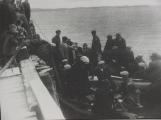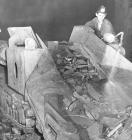15
Many workers lived in other parts of Conception Bay, and traveled to and from Bell Island. Over the decades more mine workers settled their families on the island. In 1923, Bell Island surpassed Harbour Grace as the island's second largest centre. In 1935 the population was 6,157; by 1951 it was 10, 291; and by 1961 the figure had grown to 12,281.Many who came to Bell Island to work, including those who commuted to and from nearby settlements, lived in bunkhouses known as "mess shacks". These housed up to 300 men, many of whom slept on straw mattresses, and were often not a very comfortable or pleasant environment. It is little wonder that workers from other parts of Conception Bay were eager to leave on Saturdays, and so worked extra hard on Fridays in order to make their quotas of ore.
16
Workers waiting for the man tram to take them to the surface after a shift in No. 3 Mine.August, 1949
No. 3 Mine, Bell Island, Newfoundland and Labrador

18
The Wabana ore deposit was vast, of high quality, and close enough to the Cape Breton Coal fields to feed the giant steel mills in Sydney, Nova Scotia. Bell Island ore was also shipped to more distant parts of the world, such as the United States and Germany. The iron mines drew Bell Island into the international network of the mining and steel industry, and over the period of mining operations (1895-1966), distant powers and events shaped much of the history of the mines and of the island itself.20
Drilling is the initial step in mining ore from the subterranean deposits. A certain amount of skill was required to drill rock in such a manner the greatest amount of ore may be broken, with as few holes as possible and with the use of a minimum amount of dynamite. Such skill is acquired from long experience. The average ore-face is 24 feet wide and from 9-14 feet high,22
Arranged in three horizontal of eight, 24 holes are bored into the face, ranging from 7 to 10 feet in depth, and faced a 2-foot intervals. These holes are slanted in such a way that they form a wedge in the center. When the face is blasted by a delayed action, the center is first blown free thereby providing space fro the remaining ore to break clear.24
The face-cleaners had one of the most important and dangerous jobs in the mine they had to pick away any loose ore from the walls or ceiling after the blasting. Every miner's safety depended on how well the face-cleaners did their job.25
Concentrating Plant under constructionJune, 1955
No. 3 Mine, Bell Island, Newfoundland and Labrador

26
While operations for the most part seemed to run at a steady and at times an expanding pace, there were periodic setbacks. The outbreak of the First World War, for example, was a serious blow, since Germany had been one of the chief consumers of Bell Island's ore.The period from 1936 to 1959 saw steady recovery. Although one of the mines was shut down in 1950, leaving three in operation, mine modernization projects seemed to spell prosperity.





